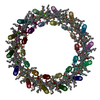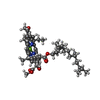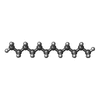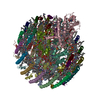[English] 日本語
 Yorodumi
Yorodumi- EMDB-36154: Cryo-EM structure of the LH1 complex from thermochromatium tepidum -
+ Open data
Open data
- Basic information
Basic information
| Entry |  | |||||||||
|---|---|---|---|---|---|---|---|---|---|---|
| Title | Cryo-EM structure of the LH1 complex from thermochromatium tepidum | |||||||||
 Map data Map data | ||||||||||
 Sample Sample |
| |||||||||
 Keywords Keywords | LH1 COMPLEX / PHOTOSYNTHESIS | |||||||||
| Function / homology |  Function and homology information Function and homology informationorganelle inner membrane / plasma membrane light-harvesting complex / bacteriochlorophyll binding / : / photosynthesis, light reaction / metal ion binding / plasma membrane Similarity search - Function | |||||||||
| Biological species |  Thermochromatium tepidum (bacteria) Thermochromatium tepidum (bacteria) | |||||||||
| Method | single particle reconstruction / cryo EM / Resolution: 3.32 Å | |||||||||
 Authors Authors | Wang G-L / Yan Y-H / Yu L-J | |||||||||
| Funding support |  China, 2 items China, 2 items
| |||||||||
 Citation Citation |  Journal: Biochim Biophys Acta Bioenerg / Year: 2024 Journal: Biochim Biophys Acta Bioenerg / Year: 2024Title: Molecular structure and characterization of the Thermochromatium tepidum light-harvesting 1 photocomplex produced in a foreign host. Authors: Yi-Hao Yan / Guang-Lei Wang / Xing-Yu Yue / Fei Ma / Michael T Madigan / Zheng-Yu Wang-Otomo / Mei-Juan Zou / Long-Jiang Yu /    Abstract: Purple phototrophic bacteria possess light-harvesting 1 and reaction center (LH1-RC) core complexes that play a key role in converting solar energy to chemical energy. High-resolution structures of ...Purple phototrophic bacteria possess light-harvesting 1 and reaction center (LH1-RC) core complexes that play a key role in converting solar energy to chemical energy. High-resolution structures of LH1-RC and RC complexes have been intensively studied and have yielded critical insight into the architecture and interactions of their proteins, pigments, and cofactors. Nevertheless, a detailed picture of the structure and assembly of LH1-only complexes is lacking due to the intimate association between LH1 and the RC. To study the intrinsic properties and structure of an LH1-only complex, a genetic system was constructed to express the Thermochromatium (Tch.) tepidum LH1 complex heterologously in a modified Rhodospirillum rubrum mutant strain. The heterologously expressed Tch. tepidum LH1 complex was isolated in a pure form free of the RC and exhibited the characteristic absorption properties of Tch. tepidum. Cryo-EM structures of the LH1-only complexes revealed a closed circular ring consisting of either 14 or 15 αβ-subunits, making it the smallest completely closed LH1 complex discovered thus far. Surprisingly, the Tch. tepidum LH1-only complex displayed even higher thermostability than that of the native LH1-RC complex. These results reveal previously unsuspected plasticity of the LH1 complex, provide new insights into the structure and assembly of the LH1-RC complex, and show how molecular genetics can be exploited to study membrane proteins from phototrophic organisms whose genetic manipulation is not yet possible. | |||||||||
| History |
|
- Structure visualization
Structure visualization
| Supplemental images |
|---|
- Downloads & links
Downloads & links
-EMDB archive
| Map data |  emd_36154.map.gz emd_36154.map.gz | 167.8 MB |  EMDB map data format EMDB map data format | |
|---|---|---|---|---|
| Header (meta data) |  emd-36154-v30.xml emd-36154-v30.xml emd-36154.xml emd-36154.xml | 15.3 KB 15.3 KB | Display Display |  EMDB header EMDB header |
| FSC (resolution estimation) |  emd_36154_fsc.xml emd_36154_fsc.xml | 11.9 KB | Display |  FSC data file FSC data file |
| Images |  emd_36154.png emd_36154.png | 92.2 KB | ||
| Filedesc metadata |  emd-36154.cif.gz emd-36154.cif.gz | 5.1 KB | ||
| Others |  emd_36154_half_map_1.map.gz emd_36154_half_map_1.map.gz emd_36154_half_map_2.map.gz emd_36154_half_map_2.map.gz | 164.8 MB 164.8 MB | ||
| Archive directory |  http://ftp.pdbj.org/pub/emdb/structures/EMD-36154 http://ftp.pdbj.org/pub/emdb/structures/EMD-36154 ftp://ftp.pdbj.org/pub/emdb/structures/EMD-36154 ftp://ftp.pdbj.org/pub/emdb/structures/EMD-36154 | HTTPS FTP |
-Validation report
| Summary document |  emd_36154_validation.pdf.gz emd_36154_validation.pdf.gz | 873.7 KB | Display |  EMDB validaton report EMDB validaton report |
|---|---|---|---|---|
| Full document |  emd_36154_full_validation.pdf.gz emd_36154_full_validation.pdf.gz | 873.2 KB | Display | |
| Data in XML |  emd_36154_validation.xml.gz emd_36154_validation.xml.gz | 20.7 KB | Display | |
| Data in CIF |  emd_36154_validation.cif.gz emd_36154_validation.cif.gz | 26.8 KB | Display | |
| Arichive directory |  https://ftp.pdbj.org/pub/emdb/validation_reports/EMD-36154 https://ftp.pdbj.org/pub/emdb/validation_reports/EMD-36154 ftp://ftp.pdbj.org/pub/emdb/validation_reports/EMD-36154 ftp://ftp.pdbj.org/pub/emdb/validation_reports/EMD-36154 | HTTPS FTP |
-Related structure data
| Related structure data |  8jc9MC  8jc8C M: atomic model generated by this map C: citing same article ( |
|---|---|
| Similar structure data | Similarity search - Function & homology  F&H Search F&H Search |
- Links
Links
| EMDB pages |  EMDB (EBI/PDBe) / EMDB (EBI/PDBe) /  EMDataResource EMDataResource |
|---|
- Map
Map
| File |  Download / File: emd_36154.map.gz / Format: CCP4 / Size: 178 MB / Type: IMAGE STORED AS FLOATING POINT NUMBER (4 BYTES) Download / File: emd_36154.map.gz / Format: CCP4 / Size: 178 MB / Type: IMAGE STORED AS FLOATING POINT NUMBER (4 BYTES) | ||||||||||||||||||||||||||||||||||||
|---|---|---|---|---|---|---|---|---|---|---|---|---|---|---|---|---|---|---|---|---|---|---|---|---|---|---|---|---|---|---|---|---|---|---|---|---|---|
| Projections & slices | Image control
Images are generated by Spider. | ||||||||||||||||||||||||||||||||||||
| Voxel size | X=Y=Z: 0.89 Å | ||||||||||||||||||||||||||||||||||||
| Density |
| ||||||||||||||||||||||||||||||||||||
| Symmetry | Space group: 1 | ||||||||||||||||||||||||||||||||||||
| Details | EMDB XML:
|
-Supplemental data
-Half map: #1
| File | emd_36154_half_map_1.map | ||||||||||||
|---|---|---|---|---|---|---|---|---|---|---|---|---|---|
| Projections & Slices |
| ||||||||||||
| Density Histograms |
-Half map: #2
| File | emd_36154_half_map_2.map | ||||||||||||
|---|---|---|---|---|---|---|---|---|---|---|---|---|---|
| Projections & Slices |
| ||||||||||||
| Density Histograms |
- Sample components
Sample components
-Entire : LH1 COMPLEX
| Entire | Name: LH1 COMPLEX |
|---|---|
| Components |
|
-Supramolecule #1: LH1 COMPLEX
| Supramolecule | Name: LH1 COMPLEX / type: complex / ID: 1 / Parent: 0 / Macromolecule list: #1-#2 |
|---|---|
| Source (natural) | Organism:  Thermochromatium tepidum (bacteria) Thermochromatium tepidum (bacteria) |
-Macromolecule #1: LH1 alpha polypeptide
| Macromolecule | Name: LH1 alpha polypeptide / type: protein_or_peptide / ID: 1 / Number of copies: 14 / Enantiomer: LEVO |
|---|---|
| Source (natural) | Organism:  Thermochromatium tepidum (bacteria) Thermochromatium tepidum (bacteria) |
| Molecular weight | Theoretical: 7.034442 KDa |
| Sequence | String: MFTMNANLYK IWLILDPRRV LVSIVAFQIV LGLLIHMIVL STDLNWLDDN IPVSYQALGK K UniProtKB: LH1 alpha polypeptide |
-Macromolecule #2: LH1 beta polypeptide
| Macromolecule | Name: LH1 beta polypeptide / type: protein_or_peptide / ID: 2 / Number of copies: 14 / Enantiomer: LEVO |
|---|---|
| Source (natural) | Organism:  Thermochromatium tepidum (bacteria) Thermochromatium tepidum (bacteria) |
| Molecular weight | Theoretical: 5.534452 KDa |
| Sequence | String: MAEQKSLTGL TDDEAKEFHA IFMQSMYAWF GLVVIAHLLA WLYRPWL UniProtKB: LH1 beta polypeptide |
-Macromolecule #3: BACTERIOCHLOROPHYLL A
| Macromolecule | Name: BACTERIOCHLOROPHYLL A / type: ligand / ID: 3 / Number of copies: 28 / Formula: BCL |
|---|---|
| Molecular weight | Theoretical: 911.504 Da |
| Chemical component information |  ChemComp-BCL: |
-Macromolecule #4: CALCIUM ION
| Macromolecule | Name: CALCIUM ION / type: ligand / ID: 4 / Number of copies: 14 / Formula: CA |
|---|---|
| Molecular weight | Theoretical: 40.078 Da |
-Macromolecule #5: SPIRILLOXANTHIN
| Macromolecule | Name: SPIRILLOXANTHIN / type: ligand / ID: 5 / Number of copies: 14 / Formula: CRT |
|---|---|
| Molecular weight | Theoretical: 596.925 Da |
| Chemical component information |  ChemComp-CRT: |
-Macromolecule #6: DODECANE
| Macromolecule | Name: DODECANE / type: ligand / ID: 6 / Number of copies: 14 / Formula: D12 |
|---|---|
| Molecular weight | Theoretical: 170.335 Da |
| Chemical component information |  ChemComp-D12: |
-Experimental details
-Structure determination
| Method | cryo EM |
|---|---|
 Processing Processing | single particle reconstruction |
| Aggregation state | particle |
- Sample preparation
Sample preparation
| Buffer | pH: 7.5 |
|---|---|
| Vitrification | Cryogen name: ETHANE |
- Electron microscopy
Electron microscopy
| Microscope | FEI TALOS ARCTICA |
|---|---|
| Image recording | Film or detector model: GATAN K3 (6k x 4k) / Average electron dose: 63.2 e/Å2 |
| Electron beam | Acceleration voltage: 300 kV / Electron source:  FIELD EMISSION GUN FIELD EMISSION GUN |
| Electron optics | Illumination mode: FLOOD BEAM / Imaging mode: BRIGHT FIELD / Nominal defocus max: 2.3000000000000003 µm / Nominal defocus min: 0.7000000000000001 µm |
| Experimental equipment |  Model: Talos Arctica / Image courtesy: FEI Company |
 Movie
Movie Controller
Controller




 Z (Sec.)
Z (Sec.) Y (Row.)
Y (Row.) X (Col.)
X (Col.)






































